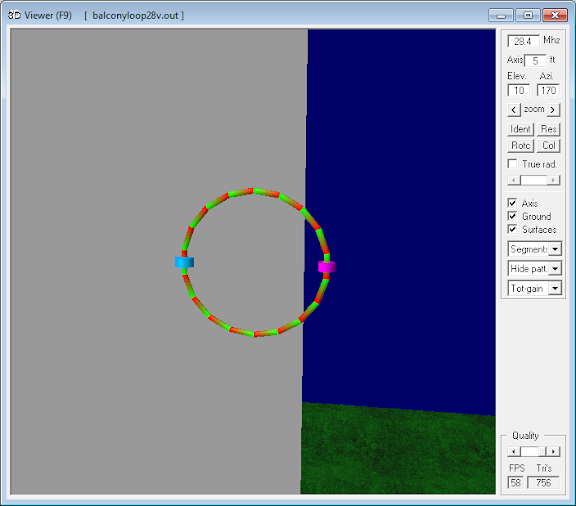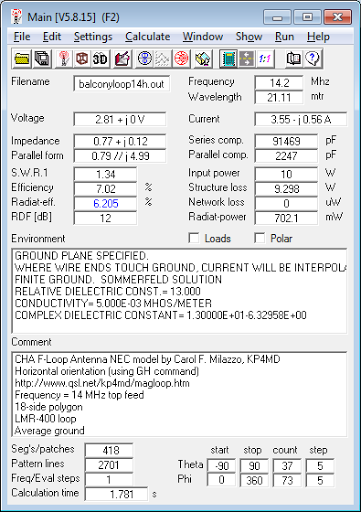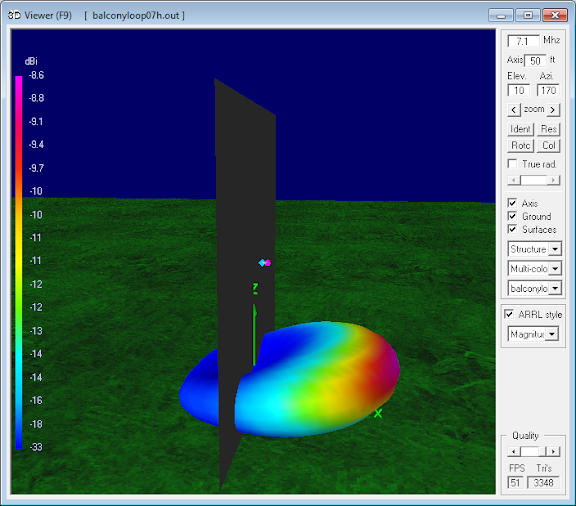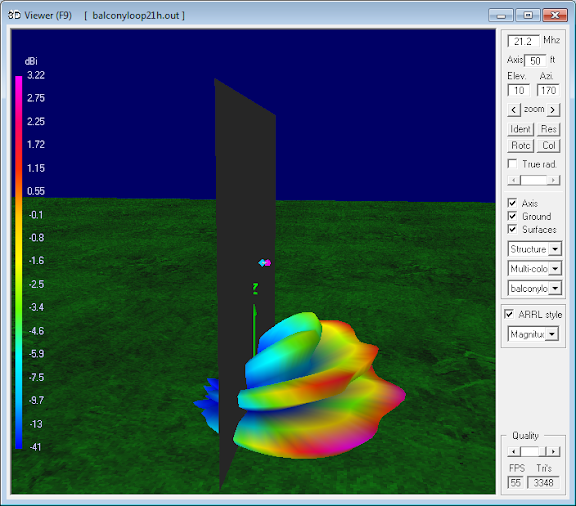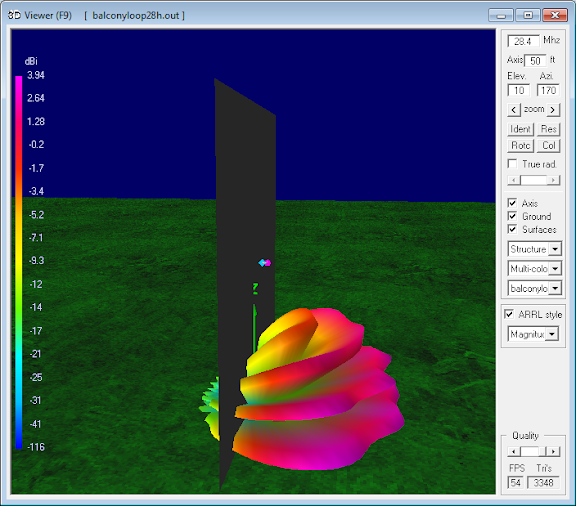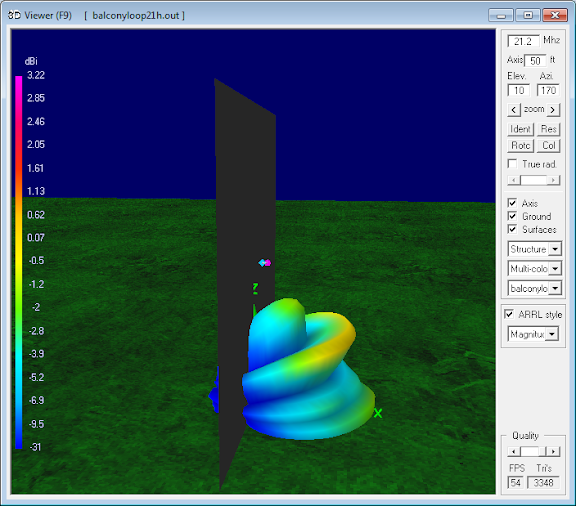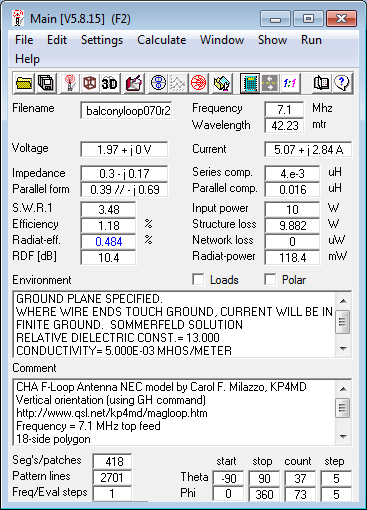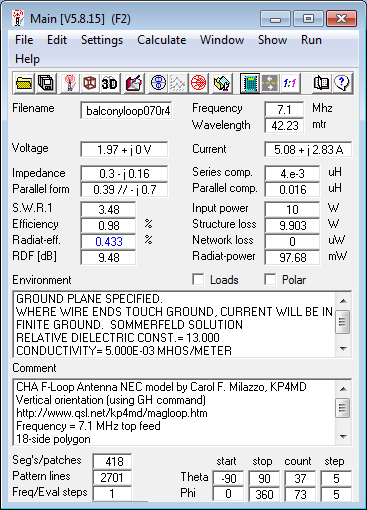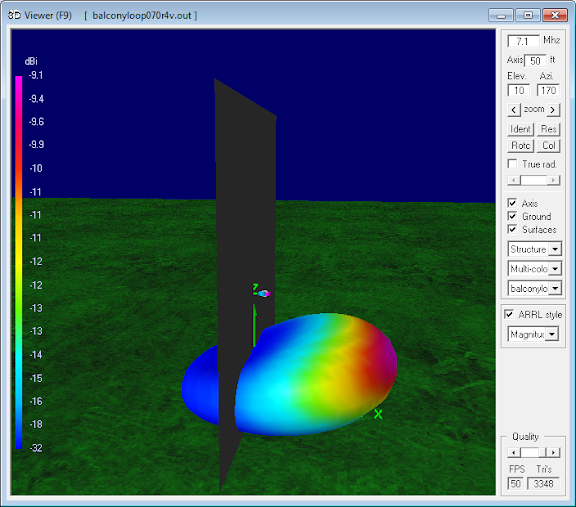CONTENTS
|
The Balcony Mounted Magnetic Loop Antenna
A NEC Model Comparative Analysis of Physical Orientation
and Performance
by Dr. Carol F. Milazzo, KP4MD (posted 12 June 2015)
E-mail: [email protected]
INTRODUCTION
The small magnetic loop is a useful compromise antenna for limited space and portability. For this reason, the magnetic loop antenna is a practical high frequency antenna solution for the restricted space of apartment dwellers. Little has been written on the effect of antenna orientation on performance in this scenario. This study presents a comparative 4nec21 model analysis on the effect of orientation of magnetic loop antennas mounted on an apartment building window or balcony with regard to antenna radiation pattern and efficiency.
MODEL DESIGN
The problem was to compare the performance of a Chameleon CHA
F-Loop Antenna, a 0.74 m (2.44 feet) diameter radiator
loop of DX Engineering DXE-400 MAX brand of LMR-400 coaxial
cable, mounted either horizontally or vertically on a balcony
railing near the center of the high rise apartment building in
Figure 1. This situation is similar to a right angle
corner reflector antenna with the ground and the building wall
as the reflectors. A validated NEC model for this antenna2
was positioned precisely over the center of a 20 � 20 square
surface patch vertical reflector measuring 40m � 40m (Figure
2). This placed the antenna at precisely 0.5 wavelength
above ground on 7 MHz, one wavelength at 14 MHz, etc. The
ground type was specified as "Average". The antenna was
positioned with its center 5 feet (1.52m) away from the
reflector with the capacitor side closest to the reflector
(Figures 3 and 4). Moving the antenna closer to the
reflecting wall resulted in Average Gain Test failure due to
limitations of the NEC code. The test was run with the
antenna resonated at 7.1, 14.2, 21.2 and 28.4 MHz. This
represents 0.5, 1, 1.5 and 2 wavelengths above ground
respectively. To observe the effect of lower antenna heights,
the test was then repeated for the 7.1 MHz resonated antenna at
0.1, 0.2, 0.3 and 0.4 wavelengths above ground.
The predicted gain will vary from the true gain as the model
does not reproduce the antenna mounted directly on a balcony
railing, nor does it account for the complex reflectivity of the
building wall nor for other reflective surfaces and obstacles
within the vicinity. The NEC surface patch offers slightly
less accuracy than a wire grid reflector but was chosen for its
fourfold faster execution.3 In any case, these
models should offer useful comparative information on the
expected efficiency and radiation pattern for each antenna
orientation.
DATA
The data are tabulated below for each tested frequency in the following order:
- Main screen (horizontal orientation);
- Main screen (vertical orientation);
- Azimuth radiation pattern for maximum gain in horizontal orientation;
- Azimuth radiation pattern for maximum gain in vertical orientation;
- Elevation radiation pattern;
- 3 dimensional radiation pattern in horizontal orientation;
- 3 dimensional radiation pattern in vertical orientation.
In each of the two dimensional radiation patterns, the red
trace is for horizontal and the blue trace is for vertical
orientation.
0.5 to 2 Wavelengths Above Ground
0.1 to 0.4 Wavelengths Above Ground
DISCUSSION
Predicted Antenna Parameters
| Parameter | Orientation | 7.1 MHz @ 0.5 λ |
14.2 MHz @ 1 λ |
21.2 MHz @ 1.5 λ |
28.4 MHz @ 2 λ |
Parameter | Orientation | 7 MHz @ 0.1 λ |
7 MHz @ 0.2 λ |
7 MHz @ 0.3 λ |
7 MHz @ 0.4 λ |
|
|---|---|---|---|---|---|---|---|---|---|---|---|---|
| Radiation efficiency | Horizontal | 1.113% | 6.205% | 12.63% | 18.94% | Radiation efficiency | Horizontal | 0.216% | 0.608% | 1.04% | 1.12% | |
| Vertical | 0.695% | 4.352% | 8.972% | 13.67% | Vertical | 0.85% | 0.484% | 0.9% | 0.433% | |||
| Major lobe elevation | Horizontal | 25� | 15� | 10� | 20� | Major lobe elevation | Horizontal | 40� | 35� | 30� | 30� | |
| Vertical | 55� | 30� | 40� | 50� | Vertical | 40� | 35� | 20� | 15� | |||
| Major lobe gain dB | Horizontal | -8.6 | 0 | 3.22 | 3.51 | Major lobe gain dB | Horizontal | -17 | -12 | -10 | -9.1 | |
| Vertical | -11 | -3.1 | 0.2 | 2.65 | Vertical | -11 | -13 | -14 | -14 |
The models predict a uniformly higher radiation efficiency and major lobe gain in the horizontal orientation for antenna heights of 0.2 wavelengths and higher. The higher efficiency is expected because in the vertical orientation half of the total radiation is directed towards the ground and therefore subject to ground absorption. At higher frequencies, the radiation pattern exhibits increasing numbers of lobes and nulls. At antenna heights of 0.5 wavelength and above, the horizontal orientation uniformly yields lower angle maximum radiation lobes that would favor long distance ionospheric propagation. At these antenna heights, the vertical orientation yields higher angle radiation lobes, offering a 7 dB signal increase over the horizontal orientation at 55� elevation for short distance near vertical incidence skywave (NVIS) propagation on 7 MHz.
CONCLUSIONS This NEC model comparison suggests that the magnetic
loop antenna is preferably REFERENCES
PHOTO ALBUMS
|
NEC Model Parameters2
In switch position B: Rc = 2 � (5800/(FMHz�CpF�) + 0.0039�√FMHz) |
4nec2 Model Files
|
||||||||||||||||||||||||||||||||||||||||||||


